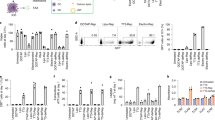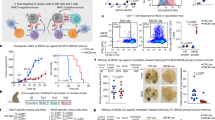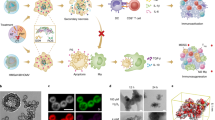Abstract
The main reason why tumours are not controlled by the immune system is that, unlike pathogens, they do not express potent tumour rejection antigens (TRAs). Tumour vaccination aims at stimulating a systemic immune response targeted to, mostly weak, antigens expressed in the disseminated tumour lesions. Main challenges in developing effective vaccination protocols are the identification of potent and broadly expressed TRAs1,2,3 and effective adjuvants to stimulate a robust and durable immune response4,5,6. Here we describe an alternative approach in which the expression of new, and thereby potent, antigens are induced in tumour cells by inhibiting nonsense-mediated messenger RNA decay (NMD)7,8,9,10. Small interfering RNA (siRNA)-mediated inhibition of NMD in tumour cells led to the expression of new antigenic determinants and their immune-mediated rejection. In subcutaneous and metastatic tumour models, tumour-targeted delivery of NMD factor-specific siRNAs conjugated to oligonucleotide aptamer ligands led to significant inhibition of tumour growth that was superior to that of vaccination with granulocyte–macrophage colony-stimulating factor (GM-CSF)-expressing irradiated tumour cells11, and could be further enhanced by co-stimulation. Tumour-targeted NMD inhibition forms the basis of a simple, broadly useful, and clinically feasible approach to enhance the antigenicity of disseminated tumours leading to their immune recognition and rejection. The cell-free chemically synthesized oligonucleotide backbone of aptamer–siRNAs reduces the risk of immunogenicity and enhances the feasibility of generating reagents suitable for clinical use.
This is a preview of subscription content, access via your institution
Access options
Subscribe to this journal
Receive 51 print issues and online access
$199.00 per year
only $3.90 per issue
Buy this article
- Purchase on Springer Link
- Instant access to full article PDF
Prices may be subject to local taxes which are calculated during checkout




Similar content being viewed by others
References
Gilboa, E. The makings of a tumor rejection antigen. Immunity 11, 263–270 (1999)
Novellino, L., Castelli, C. & Parmiani, G. A listing of human tumor antigens recognized by T cells. Cancer Immunol. Immunother. 54, 187–207 (2005)
Schietinger, A., Philip, M. & Schreiber, H. Specificity in cancer immunotherapy. Semin. Immunol. 20, 276–285 (2008)
Gilboa, E. The promise of cancer vaccines. Nature Rev. Cancer 4, 401–411 (2004)
Melief, C. J. Cancer immunotherapy by dendritic cells. Immunity 29, 372–383 (2008)
Pardoll, D. M. Spinning molecular immunology into successful immunotherapy. Nature Rev. Immunol. 2, 227–238 (2002)
Frischmeyer, P. A. & Dietz, H. C. Nonsense-mediated mRNA decay in health and disease. Hum. Mol. Genet. 8, 1893–1900 (1999)
Behm-Ansmant, I. et al. mRNA quality control: an ancient machinery recognizes and degrades mRNAs with nonsense codons. FEBS Lett. 581, 2845–2853 (2007)
Maquat, L. E. Nonsense-mediated mRNA decay: splicing, translation and mRNP dynamics. Nature Rev. Mol. Cell Biol. 5, 89–99 (2004)
Mühlemann, O., Eberle, A. B., Stalder, L. & Zamudio Orozco, R. Recognition and elimination of nonsense mRNA. Biochim. Biophys. Acta 1779, 538–549 (2008)
Jinushi, M., Hodi, F. S. & Dranoff, G. Enhancing the clinical activity of granulocyte-macrophage colony-stimulating factor-secreting tumor cell vaccines. Immunol. Rev. 222, 287–298 (2008)
El-Bchiri, J. et al. Nonsense-mediated mRNA decay impacts MSI-driven carcinogenesis and anti-tumor immunity in colorectal cancers. PLoS One 3, e2583 (2008)
Mendell, J. T., Sharifi, N. A., Meyers, J. L., Martinez-Murillo, F. & Dietz, H. C. Nonsense surveillance regulates expression of diverse classes of mammalian transcripts and mutes genomic noise. Nature Genet. 36, 1073–1078 (2004)
Usuki, F. et al. Specific inhibition of nonsense-mediated mRNA decay components, SMG-1 or Upf1, rescues the phenotype of Ullrich disease fibroblasts. Mol. Ther. 14, 351–360 (2006)
Wittmann, J., Hol, E. M. & Jack, H. M. hUPF2 silencing identifies physiologic substrates of mammalian nonsense-mediated mRNA decay. Mol. Cell. Biol. 26, 1272–1287 (2006)
Isken, O. & Maquat, L. E. The multiple lives of NMD factors: balancing roles in gene and genome regulation. Nature Rev. Genet. 9, 699–712 (2008)
Duval, A. & Hamelin, R. Mutations at coding repeat sequences in mismatch repair-deficient human cancers: toward a new concept of target genes for instability. Cancer Res. 62, 2447–2454 (2002)
Aagaard, L. et al. A facile lentiviral vector system for expression of doxycycline-inducible shRNAs: knockdown of the pre-miRNA processing enzyme Drosha. Mol. Ther. 15, 938–945 (2007)
Overwijk, W. W. et al. Tumor regression and autoimmunity after reversal of a functionally tolerant state of self-reactive CD8+ T cells. J. Exp. Med. 198, 569–580 (2003)
Hogquist, K. A. et al. T cell receptor antagonist peptides induce positive selection. Cell 76, 17–27 (1994)
Gold, L. Oligonucleotides as research, diagnostic, and therapeutic agents. J. Biol. Chem. 270, 13581–13584 (1995)
Nimjee, S. M., Rusconi, C. P. & Sullenger, B. A. Aptamers: an emerging class of therapeutics. Annu. Rev. Med. 56, 555–583 (2005)
Lupold, S. E., Hicke, B. J., Lin, Y. & Coffey, D. S. Identification and characterization of nuclease-stabilized RNA molecules that bind human prostate cancer cells via the prostate-specific membrane antigen. Cancer Res. 62, 4029–4033 (2002)
Akira, S., Uematsu, S. & Takeuchi, O. Pathogen recognition and innate immunity. Cell 124, 783–801 (2006)
Judge, A. D. et al. Sequence-dependent stimulation of the mammalian innate immune response by synthetic siRNA. Nature Biotechnol. 23, 457–462 (2005)
McNamara, J. O. et al. Multivalent 4-1BB binding aptamers costimulate CD8 T cells and inhibit tumor growth in mice. J. Clin. Invest. 118, 376–386 (2008)
Dranoff, G. et al. Vaccination with irradiated tumor cells engineered to secrete murine granulocyte-macrophage colony-stimulating factor stimulates potent, specific, and long-lasting anti-tumor immunity. Proc. Natl Acad. Sci. USA 90, 3539–3543 (1993)
van Elsas, A., Hurwitz, A. A. & Allison, J. P. Combination immunotherapy of B16 melanoma using anti-cytotoxic T lymphocyte-associated antigen 4 (CTLA-4) and granulocyte/macrophage colony-stimulating factor (GM-CSF)-producing vaccines induces rejection of subcutaneous and metastatic tumors accompanied by autoimmune depigmentation. J. Exp. Med. 190, 355–366 (1999)
Quezada, S. A., Peggs, K. S., Curran, M. A. & Allison, J. P. CTLA4 blockade and GM-CSF combination immunotherapy alters the intratumor balance of effector and regulatory T cells. J. Clin. Invest. 116, 1935–1945 (2006)
Aagaard, L. et al. A facile lentiviral vector system for expression of doxycycline-inducible shRNAs: knockdown of the pre-miRNA processing enzyme Drosha. Mol. Ther. 15, 938–945 (2007)
Li, M. J. & Rossi, J. J. Lentiviral vector delivery of recombinant small interfering RNA expression cassettes. Methods Enzymol. 392, 218–226 (2005)
Acknowledgements
We thank J. Zhang for assistance in the mouse studies, A.-M. Jegg for technical assistance in characterizing Smg1 siRNAs, J. Rossi for advising in the design of aptamer–siRNA conjugates, and S. Nair and D. Boczkowski for advice in performing T-cell assays. This work was supported by the Dodson foundation and the Sylvester Comprehensive Cancer Center (Medical School, University of Miami).
Author information
Authors and Affiliations
Contributions
F.P. suggested the approach and was responsible for designing the aptamer–siRNA conjugates and interpreting the results, D.K. was responsible for the mouse studies, P.H.G. helped design the aptamer–siRNA conjugates, and E.G. oversaw experimental design, data analysis, and wrote the manuscript.
Corresponding author
Ethics declarations
Competing interests
The authors declare no competing financial interests.
Supplementary information
Supplementary information
This file contains Supplementary Figures 1-8 with legends, a Supplementary Discussion and References. (PDF 1527 kb)
Rights and permissions
About this article
Cite this article
Pastor, F., Kolonias, D., Giangrande, P. et al. Induction of tumour immunity by targeted inhibition of nonsense-mediated mRNA decay. Nature 465, 227–230 (2010). https://doi.org/10.1038/nature08999
Received:
Accepted:
Issue Date:
DOI: https://doi.org/10.1038/nature08999
This article is cited by
-
Characterization of a rhabdomyosarcoma reveals a critical role for SMG7 in cancer cell viability and tumor growth
Scientific Reports (2023)
-
Nonsense-Mediated mRNA Decay: Mechanistic Insights and Physiological Significance
Molecular Biotechnology (2023)
-
IL-6/STAT3 signaling in tumor cells restricts the expression of frameshift-derived neoantigens by SMG1 induction
Molecular Cancer (2022)
-
Nonsense-mediated RNA decay: an emerging modulator of malignancy
Nature Reviews Cancer (2022)
-
Aberrant splicing isoforms detected by full-length transcriptome sequencing as transcripts of potential neoantigens in non-small cell lung cancer
Genome Biology (2021)
Comments
By submitting a comment you agree to abide by our Terms and Community Guidelines. If you find something abusive or that does not comply with our terms or guidelines please flag it as inappropriate.



